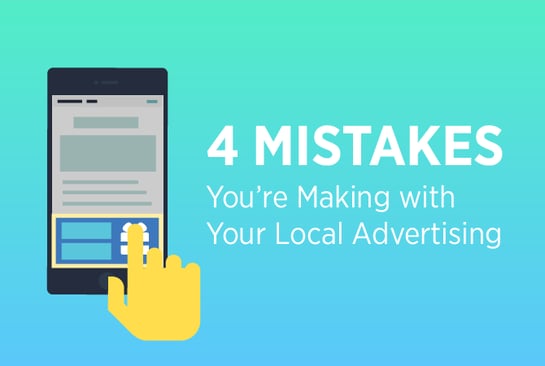Robert Djakovic | Jun 18, 2015 11:37:00 AM
4 Min Read

According to Borrell Associates, an estimated 48 billion dollars will be invested in local digital advertising in 2015. Brands across various verticals are recognizing that, although local advertising is more expensive than national advertising, it leads to a higher level of customer engagement and a better ROI. However, the rush to embrace local advertising can lead to poor outcomes when national or regional media strategies are used to target customers at the street level.
Below are the top 4 mistakes your brand is making with its local advertising, and how you can fix them to boost the bottom line.
Ads created for national distribution will not resonate with customers looking for local products and services to satisfy an immediate need. It is not enough to simply say that a product or service is available locally.
Solution: Effective ads must communicate the exact service area or cross streets of a brick-and-mortar store. Paid search ads on Google and Bing can use location extensions to display the address and phone number of storefronts. Creating separate search campaigns for each location is necessary for targeting localized search ads at local markets. Dynamic display ads can automatically adjust their messaging to tell customers where store locations are situated on a map based on a customer’s IP address. There must also be continuity between the localized ads and the local landing page, displaying content that is unique for each store and service area.
Corporate managers often develop advertising strategies using customer profiles built from demographic and psychographic data collected across the entire country. This aggregate data is then generalized to local markets when making advertising business decisions.
Solution: Customer needs can vary greatly between different markets, so local research needs to be conducted to determine how to successfully target differed geographic areas. Local store and district managers have intimate knowledge of local markets. Collecting data with focus groups or surveys is a practical way to determine local demand for specific products or services or how far a customer will travel to reach a store. This detailed insight into specific geographic regions will lead to more impactful ad creative and better geographic targeting.
In an attempt to serve ads to local markets, advertisers will target specific cities or zip codes with programmatic advertising. These targeting methods have limitations because local service areas can often encompass multiple geographic areas, making it nearly impossible to accurately target a local market using city names or zip codes.
Solution: Geo-fencing, or radius targeting, serves ads to customers based on how far the customer will travel to a business location or a professional service will travel to a customer. Geo-fencing has the added benefits of allowing advertisers to effectively exclude online users that are outside a target area, and therefore a poor prospect, which avoids serving ads that are not relevant to them.
Clicks and impressions have long been recognized as weak performance metrics for digital advertising campaigns. Goal completions like newsletter subscriptions, brochure downloads, or leads generated are now commons measures of success for advertising campaigns, but they are usually collected and analyzed at an aggregate level, ignoring the results generated for specific stores in local markets.
Solution: Tie goals to specific local stores or service areas, establish and leverage local pages to track customer phone calls, form submits or coupon downloads. This will attribute your local advertising expenditure to goal completions. Every local page should be developed with unique analytics events that track localized goal completion. In-store attribution of local advertising, is supported with traditional coupons that customers access via local pages and then redeem in stores with smart phones or old fashion paper printouts.
Winning local markets is crucial for any brand that wants to increase its national market share and gain a competitive advantage. Managers must adapt their advertising strategies to suit the unique business environment that different geographic areas demand. Advertising has always been about reaching the right customer with the right message, so leveraging good data and sound tactics will lead to successful local advertising strategies.
Recently, Where2GetIt compared the success of AMC Theatres and Regal Cinemas in another epic digital marketing Brand Battle. Unfortunately both brands missed the mark with Local Advertising, falling to effectively target their online advertisements at a local level. Read our Brand Battle Analysis for more information.
Topics: Local Advertising
Digital marketing professional, MBA, and amateur photographer.
Offer Post Justifications Spotted in Local Results
Oct 4, 2021 8:47:46 AM
Monday Memo: More than Brands and Influencers, Consumers Trust Each Other
Sep 27, 2021 7:56:34 AM
Monday Memo: Google Adds “Latino-Owned” to GMB Identity Attributes
Sep 20, 2021 7:58:58 AM
Monday Memo: New Study Shows 94% of Consumers Use Online Business Directories
Sep 13, 2021 7:16:55 AM
Monday Memo: The Page Experience Update Has Fully Rolled Out
Sep 6, 2021 7:43:45 AM